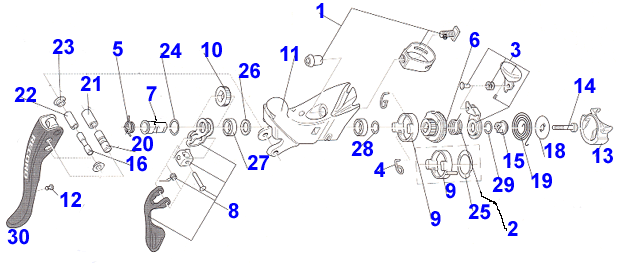Campagnolo Spare Parts Stock
Thirty parts exist in a typical Campy Ergopower shifter. The mechanism is more or less the same from Chorus to Veloce & Super Record. If you understand the basics of the diagram below, you can repair any of the Campy shifters.
One of the differences that I have noted is that Part#7, the Central Pivot Shaft Bolt, is a different length in 2001-2003 series, than the more recent models.
Taking Apart the Campy Ergo Lever
Parts blow-outof Campy Ergopower Spare Parts
Parts Explosion for Campagnolo Record Ergopower Titanium Shifter
http://branfordbike.com/
Ergo Lever Part #1
Part #1. Bolt that attaches entire shifter block to the handlebar: Handlebar Clamp Band with the Nut and Bolt.
Part #2. Thumb Button Return Spring: specific for left or right derailleurs.
Part #3. Thumb Button Return Lever: this is the lever that returns the cable to the higher gear than it is currently in.
Part# 4. G-springs: the most disposable part of the shifter lever. When your Ergo Lever loses that satisfying click, it is often time to replace the G-springs. The picture below shows the case that the springs sit in and the case. The case can break according to Brian at Vecchio’s. He recommends replacing the case when you replace the G-springs. There is a slightly different model when you buy the replacement carrier. Certain models of Ergo levers come with alloy carrier cases. I hear they are offering the replacement carriers is plastic now that supposedly last longer. Buy G-springs E-bike Stop.
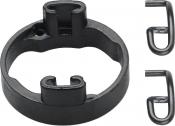
Part #5. Finger Shift Lever Return: this little spring sits directly underneath the lever. When you depress the lever to look inside the casing, you will see this spring. Do not simply grab the 3 mm and loosen the bolt… you must remove the spring first. Detach the spring by using a strong pokey stick that you can put into tight places and pick the spring anchor off the spring stop shelf.
Part #6. Index Gear: this is the burliest part of them all. This is where it is most obvious that gears churn within the casing. All the other springs and parts look too little to form anything substantial. To buy it, I found the index gear on Universal Cycles’ website. Make sure you specify the left or right one.
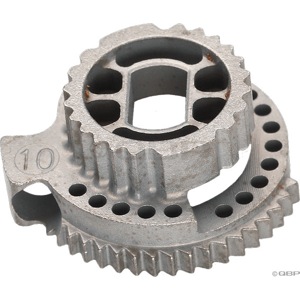
Part #7. Central Pivot Shaft: this part was the source of the biggest issue in the current Ergo project. It arrived from out of state from a client that found my blog post on the rebuild. The pivot shaft was torched.
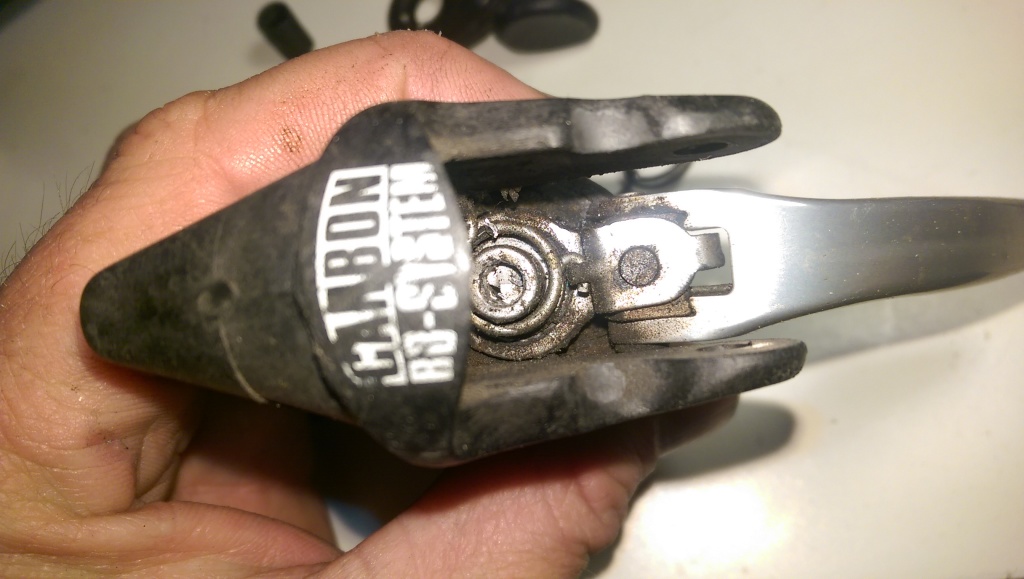
Part#8 Finger Shift Lever Assembly: this part is one of the more expensive replaceable parts within the lever. Probably because it is machined and the fact that it is the lever. Estimated cost per part from $40-$80. At the tip of it is a little circle that holds doo-dad that holds the click. The front of the lever is broken down below. See the spring? That is removed first. Poke at the ledge that sits in the handle and pick it out when you pop the spring from the spot within the casing that the spring sits.
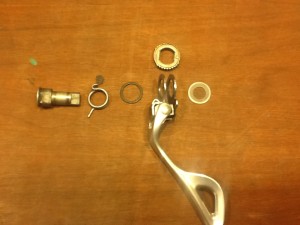
Part# 9 Carrier Case; the carrier case holds the G-springs which define the click within the assembly. The G-springs wear out faster than any other part. When the shifter feels weaker, it is likely the G-springs that need to be replaced. Depending on the supplier, the G-springs can come with the carrier. If the G-springs are sold with the carrier, it is a good idea to replace the carrier as well.
Part#10 Within the shifter level assembly is a clicker that looks like a clock piece. It tucks right into the assembly above the handle between the two circles that look like washers. To set this swivel into the assembly, study the silent video produced by Campagnolo. It is titled “2008 Record 10sp Ergopower Complete Overhaul”. As we have noted before, the assembly is more or less the same throughout the years. It is a great video. It has no words and tells you everything you need to know.
Video Time 2:30 to 3:10
The Ergo Lever Shifter video shows the show Campy man installing the front part of the shifter. At this point in the video, he has taken the whole thing apart and placed it on a blue cloth. He is now ready to piece the thing back together. He starts from the front.
Hardened Plastic Casing: From the tip of the shifter, the casing extends downward to provide a grip for the hands. Adorning the cap of the hand portion are holes for the gear and brake cables. Inside the casing, careful incisions into the casing walls have been cut to act as spring stops so that the coil can load up and be ready to turn the next thing. A hole is in the middle of the casing that acts as a house for all the shifter machinery. On either side of the inner wall with an opening between the two shifter casing rooms. There is a front part with the brake lever, a nifty spring latched into the housing and to the gear shifter lever. The gear shifter lever is one of two handheld levers that act as the Ergpower integrated shifter that includes braking and ability to change cadence with the flip of a switch. Between the left & right cases, the brake and cable holes are flipped as is the opening on the inner side for the tap down switch which releases cable tension and thus puts it in a higher gear. A higher gear in pedaling takes more pedal strength to love it. Lower gears are for easier cadences. The holes that act as a spring stops are mirror opposites between the right and left shifter cases.
On the back side of that hole sits the carrier #9 with the g-springs #4. On the front side of the wall in the building that is the Campy shifter housing, the shifter lever has an assembly sitting on top of it which includes two washers facing each other with a short distance between them where the clock gear thing goes.
The gear and a spring via the bolt that holds the spring in the right place for it to react when the lever is pressed.
Shifter lever assembly #8, the handle for the rider to affect the cable tension and a mechanism to hold two washers standing straight up facing each other from 3mm away. In that three millimeters, the rotating clock thing #10, slides in between the standing washers.
Part #10 in between the two circular washes facing each other with 2.5 mm between them. The little clock fits snuggly in the circle of fun with the clear side showing inwards to the center of the handlebar if it were attached. The video features a right handed 10 speed. The non-hitched side of the “clock” is on the left for the rear derailleur and on the left for the front derailleur.
in the video show you how to add the center pivot bolt with the shifter lever, part #10 installation of 5, 6, 24, 26 and 27.
Part #11. Hardened Plastic Casing: From the tip of the shifter, the casing extends downward to provide a grip for the hands. Adorning the cap of the hand portion are holes for the gear and brake cables. Inside the casing, careful incisions into the casing walls have been cut to act as spring stops so that the coil can load up and be ready to turn the next thing. A hole is in the middle of the casing that acts as a house for all the shifter machinery. On either side of the inner wall with an opening between the two shifter casing rooms. There is a front part with the brake lever, a nifty spring latched into the housing and to the gear shifter lever. The gear shifter lever is one of two handheld levers that act as the Ergpower integrated shifter that includes braking and ability to change cadence with the flip of a switch. Between the left & right cases, the brake and cable holes are flipped as is the opening on the inner side for the tap down switch which releases cable tension and thus puts it in a higher gear. A higher gear in pedaling takes more pedal strength to love it. Lower gears are for easier cadences. The holes that act as a spring stops are mirror opposites between the right and left shifter cases.
Not shown: Rubber Casing: outermost layer, a pliable sheath of rubber that takes finger strength to pull over the hardened plastic casing just beneath it.
My first attempt to describe how to put a Campy lever back together:
http://www.standardbikerepair.
2nd Best Site for Examining the construction of a Campagnolo shifter:
http://www.cyclecycle.info/campagnolo-ergo-shifter-assembly


